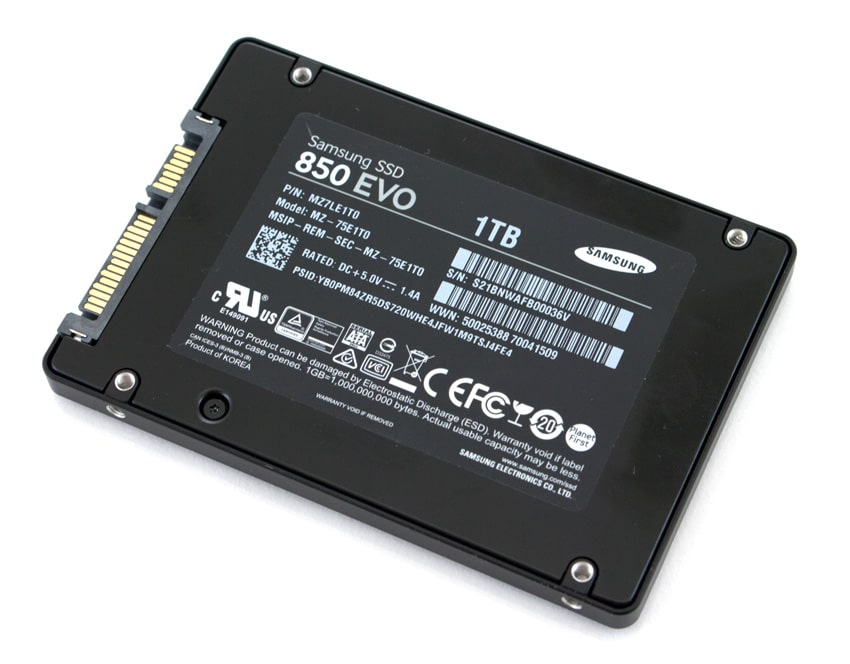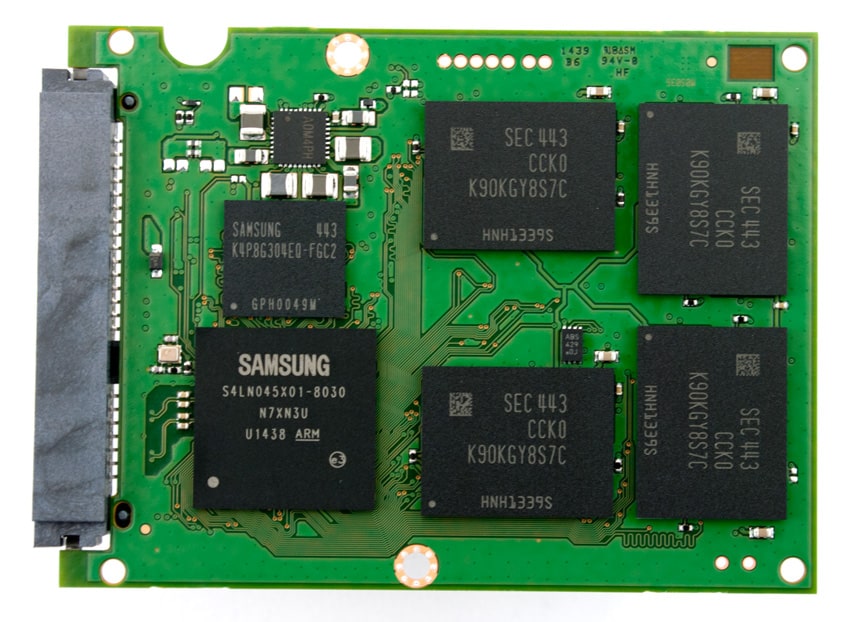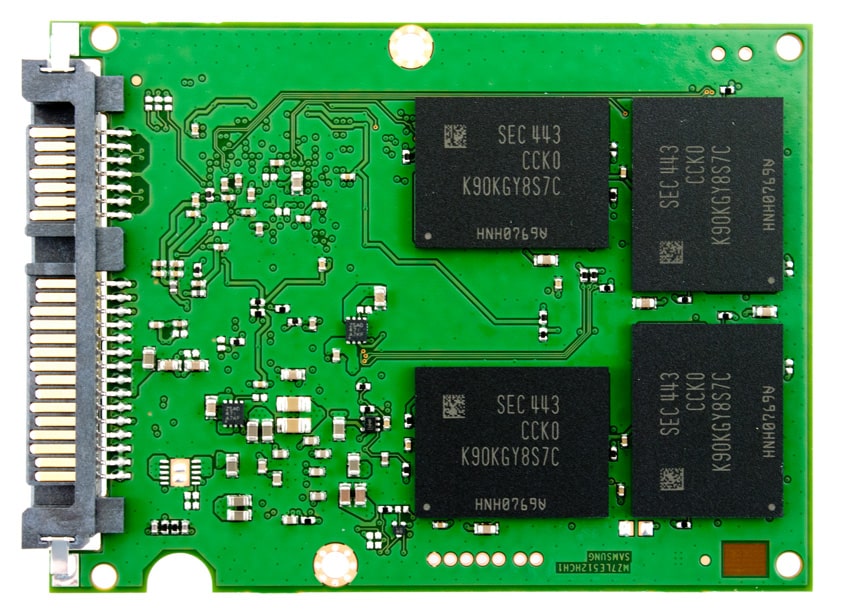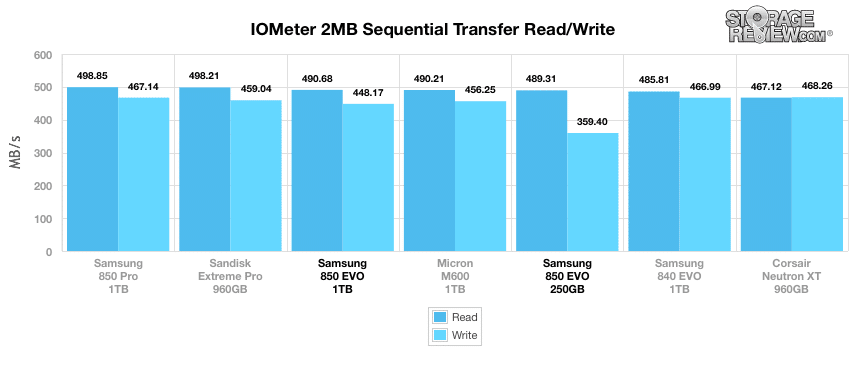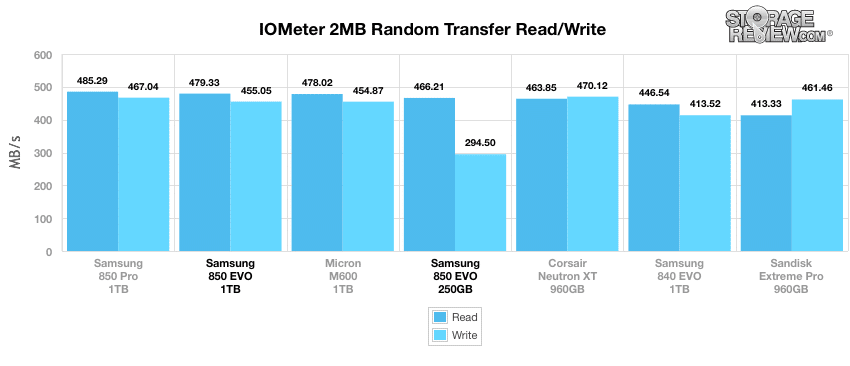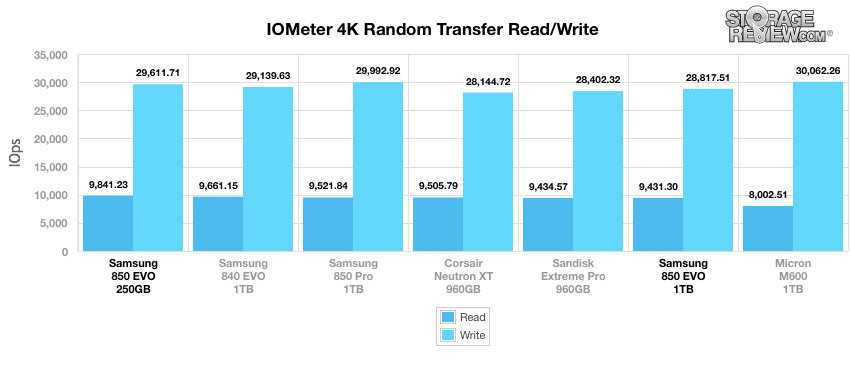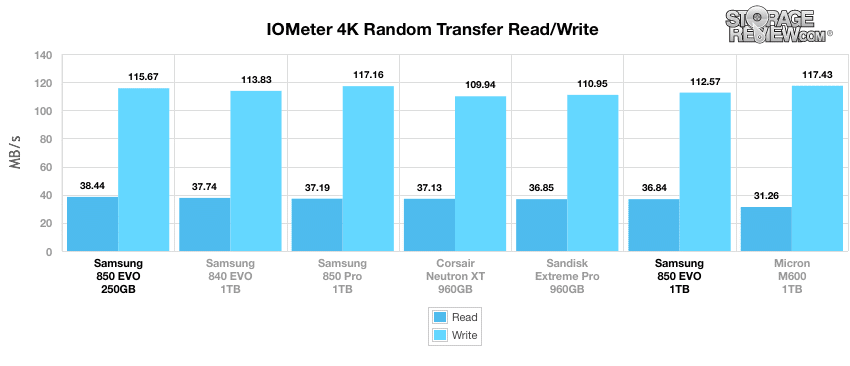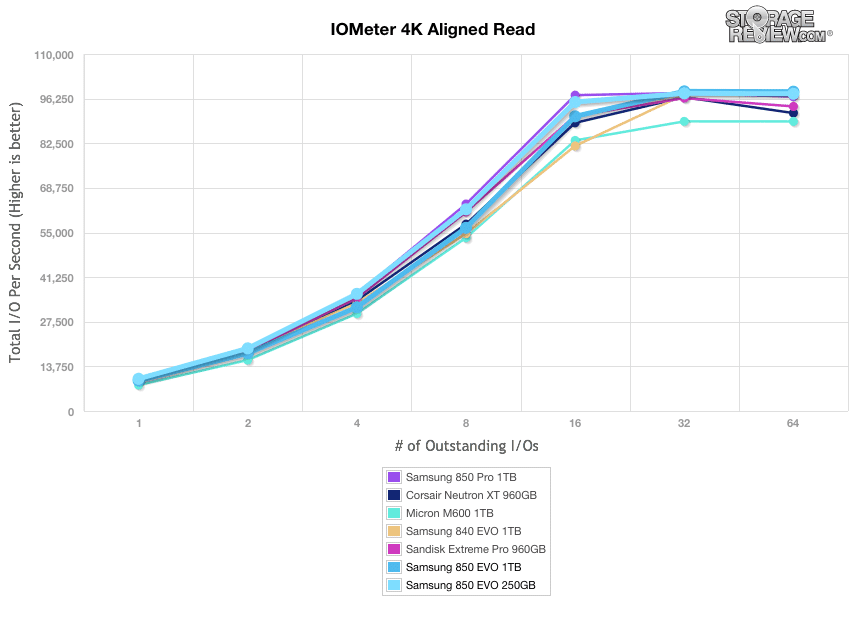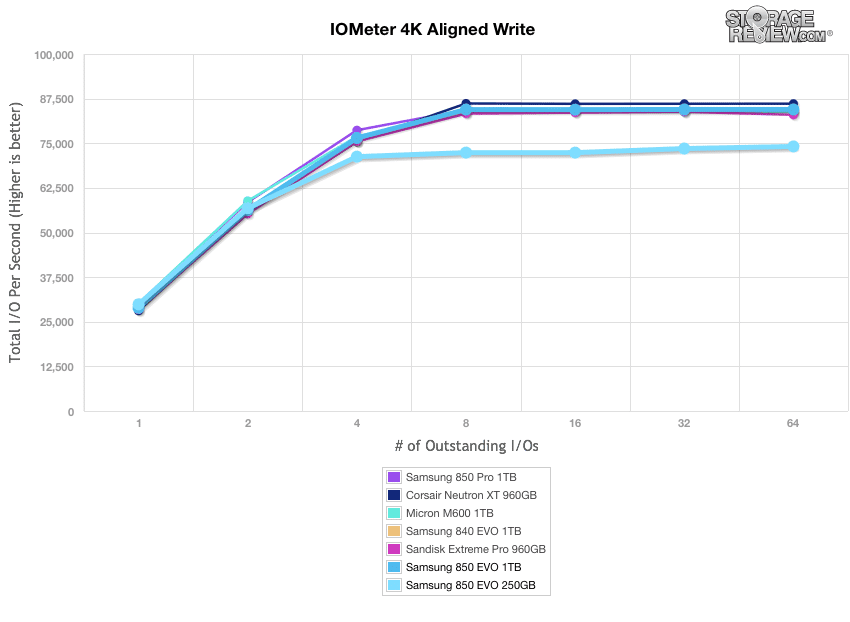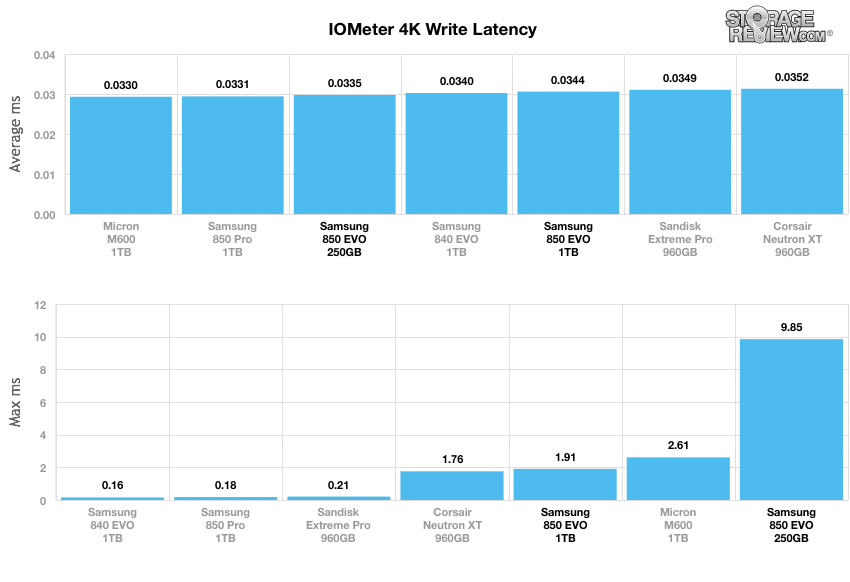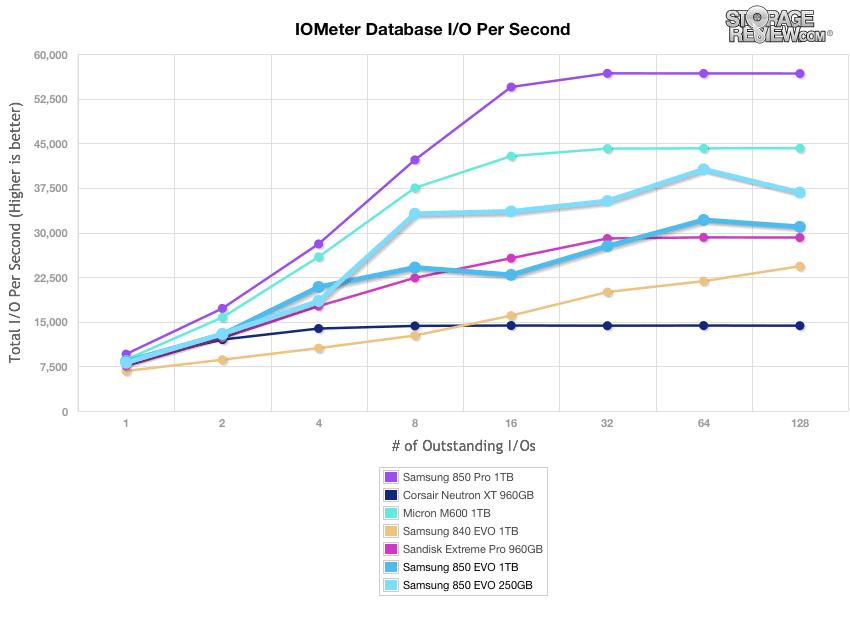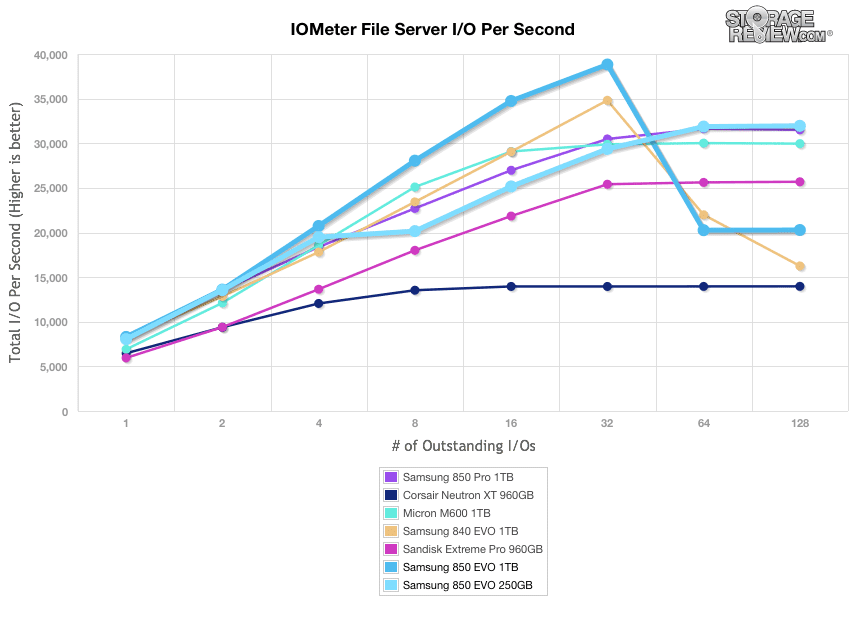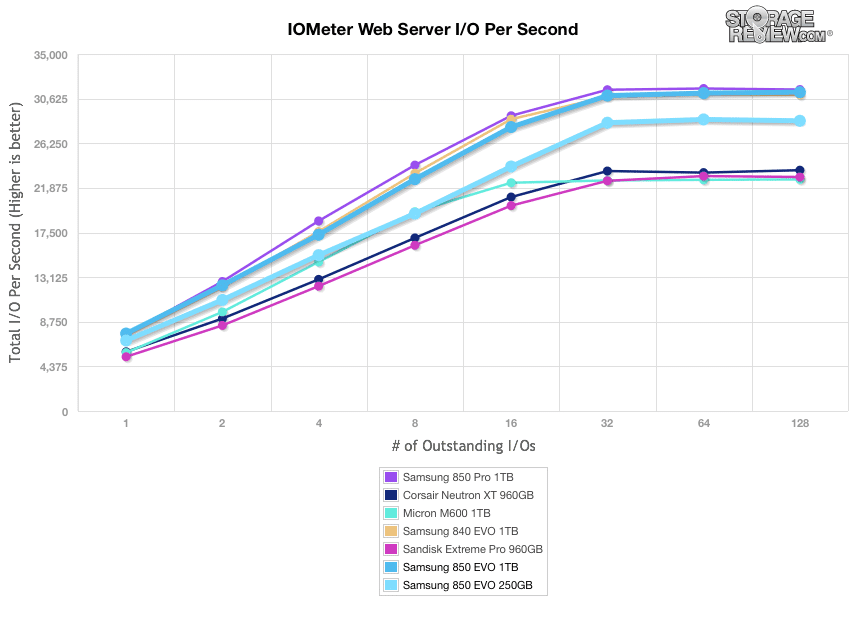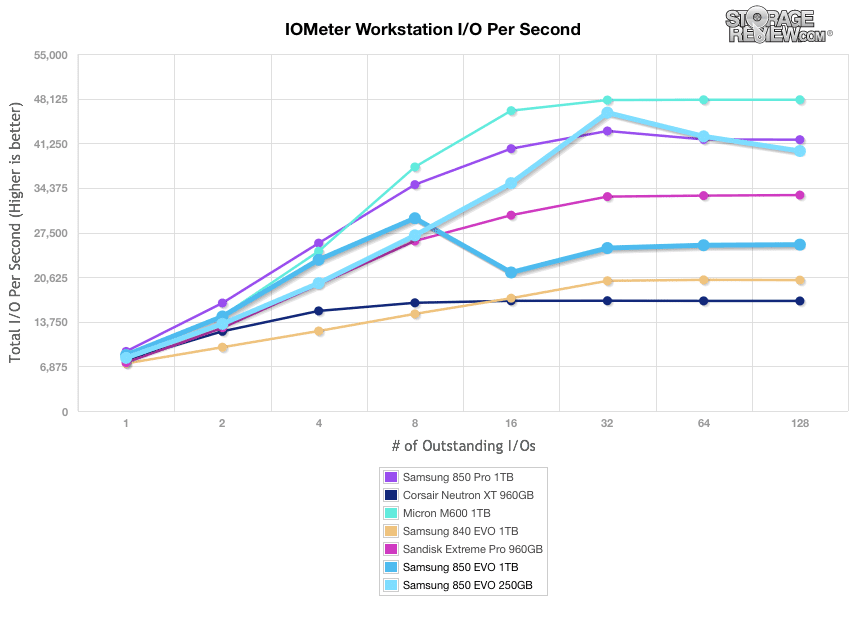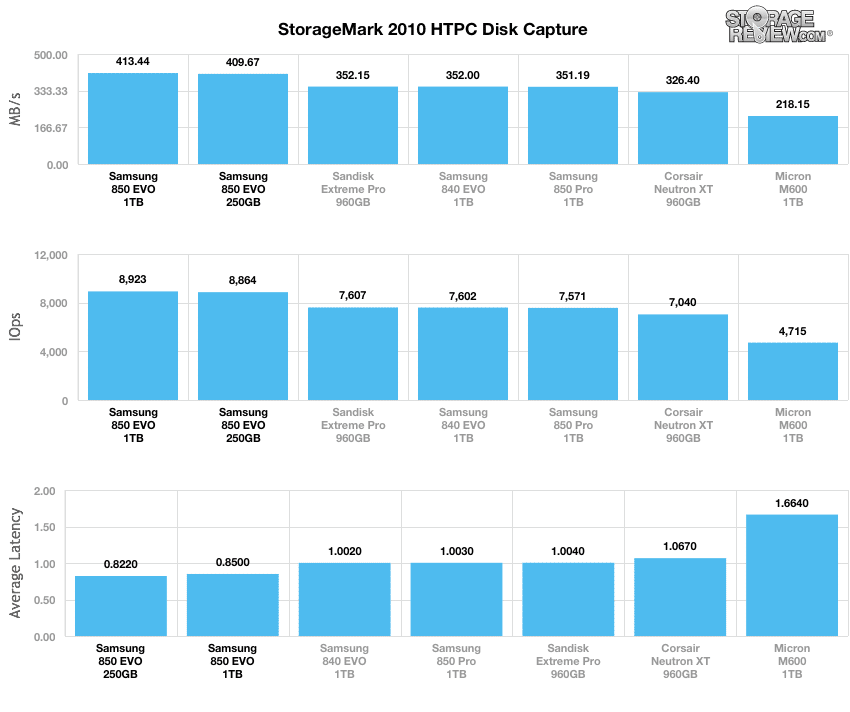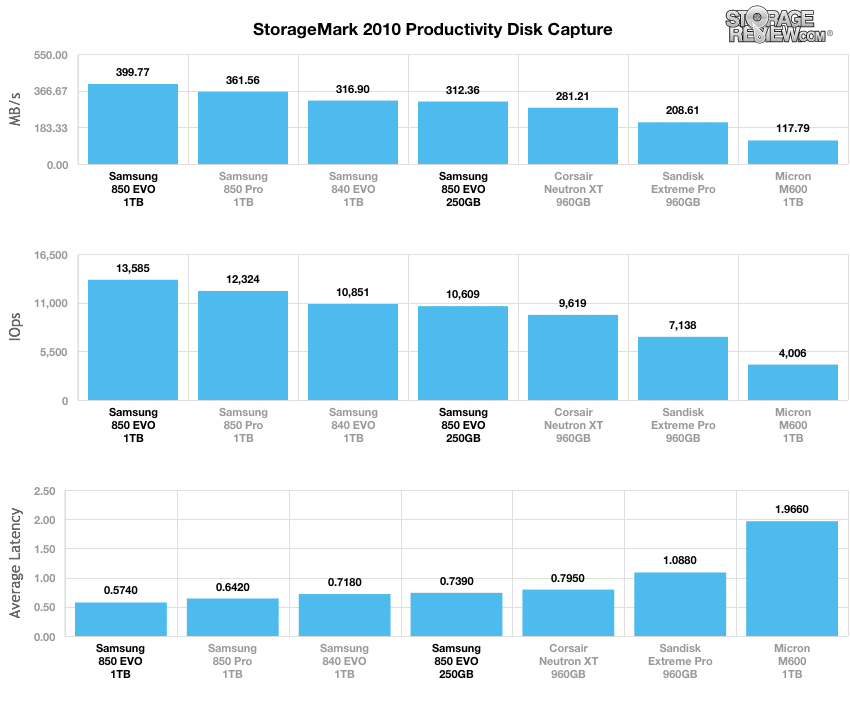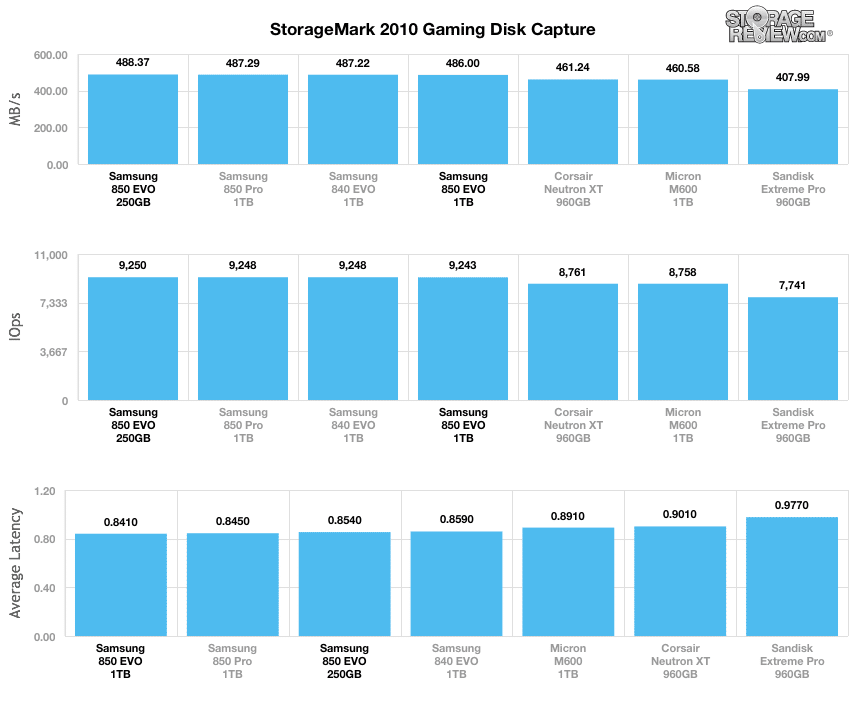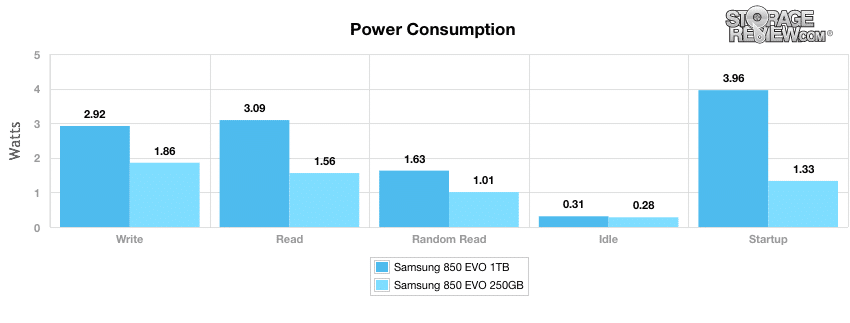
The 850 EVO, announced today, is a mainstream client SSD that is designed for superior performance and reliability during everyday computing. Samsung has really been hitting it out of the park with their storage devices these past few years, so we are always excited to see what their new SSDs are capable of with each iteration. If the 840 EVO is any indication of how well its successor will perform, Samsung’s new SSD has a ton of potential to be relevant for a very long time.
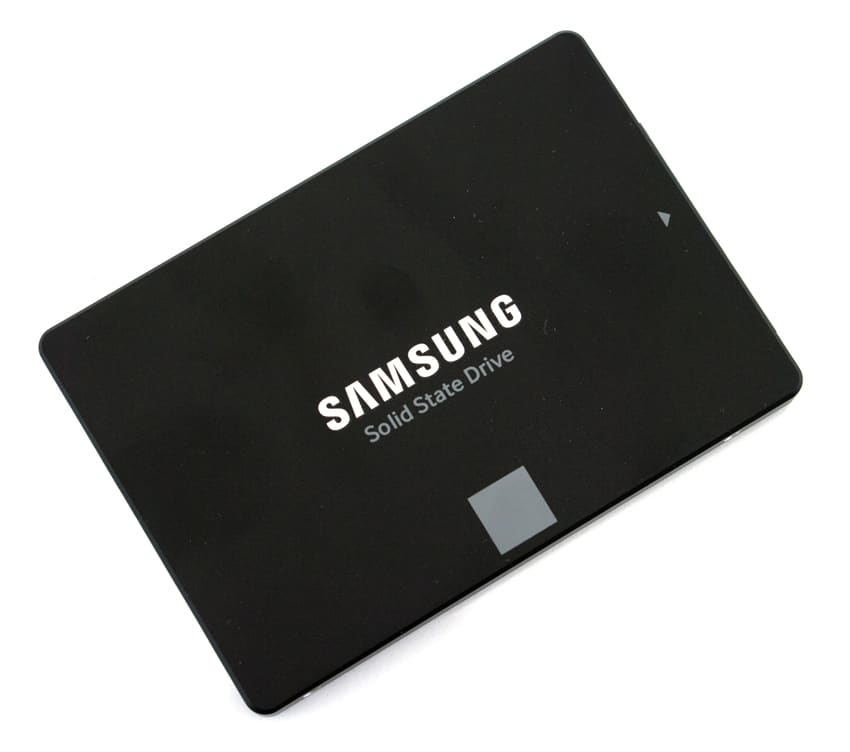
Under the hood lays 3D V‐NAND technology with TurboWrite for improved performance and Samsung’s in-house controllers. This will allow the 850 EVO to offer a better user experience than 840 EVO as well as up to 1.9x faster random write speeds for the 120GB and 250 GB models, says Samsung. The architecture of the 850 EVO actually blends technology from both the EVO and Pro lines. On the NAND side, the TLC evolution of V-NAND picks up from the PRO series which has been using V-NAND for half a year. On the controller side, Samsung actually uses two in this line, a lower power 2-core MGX for the smaller capacities and the standard 3-core MEX for the 1TB SSD that was also used in the 850 Pro.
The combination of hardware and firmware tuning gives the SSD 850 EVO pretty impressive sequential read and write speeds across all capacities, with 540MB/s and 520MB/s respectively. In addition, the 850 EVO offers a 5-year warranty and impressive endurance numbers. The SSD 850 EVO supports Total Bytes Written (TBW) of 75TBW for the 120/250GB drives and 150TBW for the 500GB/1TB capacities. This is up from 44TBW in the 840 EVO, a direct benefit of the move to 3D V‐NAND Flash which allows for greater endurance.
Samsung’s new 850 EVO also comes equipped with various power‐saving functionality, with the company claiming that the driver actually saves up to 30% more on power than the 840 EVO during write operations. This is in part due to its use of the above mentioned 3D V‐NAND, which consumes half the power of Planar 2D NAND-based SSDs. In addition, the 850 EVO features support for Device Sleep at 2mW (for the 120GB, 250GB, and 500GB models), allowing for longer battery life in supported systems. The SSDs also support AES 256‐bit Full Disk Encryption (FDE) and TCG/Opal V2.0.
Backed by a 5-year warranty, the Samsung 850 EVO ships in capacities of 120GB ($99.99), 250GB ($149.99), 500GB ($269.99), and 1TB ($499.99). We will be looking at the 250GB and 1TB units for this review.
Samsung SSD 850 EVO Specifications
- Capacities: 120GB, 250GB, 500GB, 1TB
- Dimensions (LxWxH): 100 x 69.85 x 6.8 (mm)
- Interface: SATA 6Gb/s (compatible with SATA 3Gb/s and SATA 1.5Gb/s)
- Form: Factor 2.5 inch
- Controller
- 120/250/500GB : Samsung MGX controller
- 1TB: Samsung MEX controller
- NAND Flash Memory: Samsung 32 layer 3D V‐NAND
- DRAM Cache Memory: 256MB (120GB) or 512MB (250GB&500GB) or 1GB (1TB) LPDDR2
- Performance
- Sequential Read: Max. 540 MB/s
- Sequential Write: Max. 520 MB/s
- 4KB Random Read (QD1): Max. 10,000 IOPS
- 4KB Random Write(QD1): Max. 40,000 IOPS
- 4KB Random Read (QD32):
- Max. 98,000 IOPS (500GB/1TB)
- Max. 97,000 IOPS (250GB)
- Max. 94,000 IOPS (120GB)
- 4KB Random Write(QD32):
- Max. 90,000 IOPS (500GB/1TB)
- Max. 88,000 IOPS (120GB/250GB)
- Data Security
- AES 256‐bit Full Disk Encryption (FDE)
- TCG/Opal V2.0, Encrypted Drive (IEEE1667)
- Weight Max.: 66g (1TB)
- Reliability MTBF: 1.5 million hours
- TBW
- 120/250GB: 75TBW
- 500GB/1TB: 150 TBW
- Power Consumption
- Active Read/Write (Average): Max. 3.7W(1TB)/ Max. 4.4W(1TB)
- Idle: Max. 50mW
- Device Sleep: 2mW (120/250/500GB), 4mW(1TB)
- Supporting features: TRIM (Required OS support), Garbage Collection, S.M.A.R.T
- Temperature
- Operating: 0°C to 70°C
- Non‐Operating: ‐40°C to 85°C
- Humidity: 5% to 95%, non‐condensing
- Vibration:
- Non‐Operating: 20~2000Hz, 20G
- Shock Non‐Operating: 1500G , duration 0.5m sec, 3 axis
- Warranty: 5 years limited
Design and build
The design of the Samsung 850 EVO SSD’s follows that of prior Samsung SSDs with a modified paint scheme, this time a black chassis/light grey font. As such, The 850 EVO features a very attractive and minimalistic look-and-feel. The new Samsung SSD consists of a solid metal construction for a rugged composition, featuring Samsung branding at the top of the drive. It is of 7mm z-Height, allowing it support a wide range of applications including notebooks, desktops, and ultrabooks.
On the back panel, the SSD features the product information label that offers users relevant information including the capacity and serial number. The side profiles show four screw holes that allow the 840 EVO to be seamlessly mounted.
To remove the cover, simply unscrew the 3 screws located on the back panel (note that two of them are hidden under the product label).
The 850 EVO uses a Samsung MGX controller (2-core) with the 120GB, 250GB, and 500GB capacities while the 1TB uses the Samsung MEX controller (3-core). The storage derives from the drive’s use of Samsung’s 32 layer TLC 3D V‐NAND and 256MB (120GB) or 512MB (250GB, 500GB) or 1GB (1TB) LPDDR2 for the DRAM Cache. The Samsung SSD 850 EVO uses a SATA 6Gb/s interface, though it is also compatible with SATA 3Gb/s and SATA 1.5Gb/s.
Consumer Synthetic Benchmarks
All consumer SSD benchmarks are conducted with the StorageReview HP Z620 Consumer Testing Platform. The comparables used for the review below include:
- Samsung SSD 850 PRO (1TB, Samsung 32 layer 3D V-NAND, Samsung MEX S4LN045X01-803 controller, SATA)
- Samsung SSD 840 EVO (1TB, Samsung MEX controller, 19nm Samsung TLC NAND, SATA)
- Corsair Neutron XT (960GB, Toshiba A19 MLC NAND. Phison PS3110-S10, SATA)
- Micron M600 (1TB, 16nm NAND, Marvell 88SS9189-BLD2 controller, SATA)
- SanDisk Extreme Pro (960GB, SanDisk 1Ynm, eX2 ABL MLC Flash, SATA)
With the Samsung SSD 850 EVO SSD, we tested the raw drive only and without RAPID turned on.
In our first test measuring 2MB sequential performance, the Samsung 850 EVO SSD (1TB) posted 490.68MB/s read and 448.17MB/s write, while the 250GB model measured had a similar read speed at 489.31MB/s but a much slower write activity at 359.40MB/s write. The 1TB ranked third among the comparables in read, though it was right at the bottom in write with the 250GB model.
Our next test looks at 2MB random transfer performance. Here, the Samsung 850 EVO 1TB read and write activity measured 479.32MB/s and 455.05MB/s, while the 250GB model measured 466.20MB/s read and only 294.50MB/s write. The top performer in the read column was the higher-end Samsung 850 Pro model with 485.29MB/s, while the Corsair Neutron had the best write activity at 470.12MB/s.
Next, we switch to smaller 4k random transfers. In this test, the Samsung 850 EVO 1TB measured 9,431.30 IOPS for read activity and 28,817.51 IOPS for write activity, while the Samsung 850 EVO 250GB measured an impressive first place read IOPS with 9,841.23 for reads and a respectable 29,611.71 IOPS for writes. In our 4K random transfer tests, the smaller Samsung 840 EVO drive outpaced the 1TB model in speed.
In our next test, we shift to a smaller 4k random workload with 100% read activity that scales from 1QD to 64QD. In this profile, the Samsung 850 Evo 250GB measured from 9,935.21 IOPS up to 97,869.77 IOPS. The 1TB model had a slower burst speed at 9,366.66 IOPS but finished off with a better 98,491.28 IOPS, which was first place among the comparables. As expected, the Pro model was hot on its heels with 97,995.86 IOPS.
Moving to write activity, the Samsung 850 Evo 1TB continued its good performance with 28,891.35 IOPS at QD1 and peaking at 84,464.49IOPS in the terminal queue depths, which was 2nd place among the other SSDs. Like with our read workload, the 250GB model had better burst throughput with 29,889.00 IOPS and but fell short in the last queue depths with only 74,100.30 IOPS.
When comparing average write latency between each mainstream consumer SSD, the Samsung 850 Evo 1TB had an average response time of 0.0344ms and a peak latency of 1.907ms, both of which placed the drive in the middle of the pack. The 250GB model posted a better average response time of 0.0335ms, though a much higher peak latency with 9.848ms (which was last place among the comparables). The top average latency SSD was the Micron M600 (0.0329ms) while the top max latency performer was the Samsung 840 Evo with only 0.157ms.
Our last series of synthetic benchmarks compare the hard drives in a series of server mixed-workloads with a queue depth of ranging from 1 to 128. Each of our server profile tests has a strong preference towards read activity, ranging from 67% read with our database profile to 100% read in our web server profile. In all of our mixed workloads the Samsung SSD 840 ranked at the bottom of the pack except the Web Server profile where the 840 and 840 Pro drives were highly successful.
The first is our database profile, which consists of a 67% read and 33% write workload mix primarily centered on 8K transfer sizes. Here, only the Samsung Pro and Micron M600 outperformed the 1TB Samsung 850 Evo (36,708.87 IOPS) by a large margin in the terminal queue depths. The 250GB model posted 30,945.06 IOPS by 128QD.
The next profile looks at a file server, with 80% read and 20% write workload spread out over multiple transfer sizes ranging from 512-byte to 64KB. The Samsung 850 Evo drives both boasted great QD1 throughput, though the 1TB model finished well ahead of the 250GB model in the terminal queue depths, taking first place with 31,952.73 IOPS.
Our web server profile is read-only with a spread of transfer sizes from 512-byte to 512KB. The Samsung 850 Evo drives again offered great QD1 performance, but the 1TB model separated itself from the two in the later QDs with a final IOPS of 31,259.11, which was just behind the Samsung 850 Pro version.
The last profile looks at workstation activity, with a 20% write and 80% read mixture using 8K transfers. This time, the 250GB 850 Evo model boasted the best performance of the two capacities, taking 2nd place (just behind the 850 Pro) with 40,055.64 IOPS. The 1TB model ranked near the lower-middle of the pack.
Consumer Real-World Benchmarks
For the average consumer, trying to translate random 4K write speeds into an everyday situation is pretty difficult. It helps when comparing drives in every setting possible, but it doesn’t exactly work out into faster everyday usage or better game loading times. For this reason we turned to our StorageMark 2010 traces, which include HTPC, Productivity, and Gaming traces to help readers find out how a drive might rank under these conditions.
The first real-life test is our HTPC scenario. In this test we include: playing one 720P HD movie in Media Player Classic, one 480P SD movie playing in VLC, three movies downloading simultaneously through iTunes, and one 1080i HDTV stream being recorded through Windows Media Center over a 15 minute period. Higher IOps and MB/s rates with lower latency times are preferred. In this trace we recorded 2,986MB being written to the drive and 1,924MB being read.
In our HTPC profile, both Samsung 850 Evo capacities crushed their competition. The 1TB Evo provided an average speed of 413.44MB/s, while the 250GB boasted 409.67MB/s. Results were the same in average latency and in throughout, which the two drives handedly beat out the rest of the consumer SSDs.
Our second real-life test covers disk activity in a productivity scenario. For all intents and purposes this test shows drive performance under normal daily activity for most users. This test includes: a three hour period operating in an office productivity environment with 32-bit Vista running Outlook 2007 connected to an Exchange server, web browsing using Chrome and IE8, editing files within Office 2007, viewing PDFs in Adobe Reader, and an hour of local music playback with two hours of additional online music via Pandora. In this trace we recorded 4,830MB being written to the drive and 2,758MB being read.
In our Productivity trace, the Samsung 840 Evo drives performed well again, though this time not by as big of a margin as our last test. Still, the Samsung 850 Evo 1TB offered the best performance in all categories, registering 399.77MB/s, which was well over three times the performance of the Micron M600. The 250GB averaged 312.36MB/s, which was middle of the pack performance.
Our third real-life test covers disk activity in a gaming environment. Unlike the HTPC or Productivity trace, this one relies heavily on the read performance of a drive. To give a simple breakdown of read/write percentages, the HTPC test is 64% write, 36% read, the Productivity test is 59% write and 41% read, while the gaming trace is 6% write and 94% read. The test consists of a Windows 7 Ultimate 64-bit system pre-configured with Steam, with Grand Theft Auto 4, Left 4 Dead 2, and Mass Effect 2 already downloaded and installed. The trace captures the heavy read activity of each game loading from the start, as well as textures as the game progresses. In this trace we recorded 426MB being written to the drive and 7,235MB being read.
In our read-intensive Gaming trace, the Samsung 850 EVO drives performed very well, once again. The 1TB and 250GB capacities posted 486.0MB/s (fourth) and 488.37MB/s (first), respectively.
Power
Our power tests showed significantly lower consumption with the 250GB 850 EVO (186.ms write, 1.56ms read, 1.01ms random read, 0.28ms idle and 1.33ms startup) compared to the 250GB 840 EVO (2.63ms write, 280ms read, 1.52ms random read, 0.30ms idle, and 1.53ms startup). Our 1TB model showed much higher power values, as expected, due to the increased RAM and NAND.
Conclusion
The SSD 850 EVO continues Samsung’s trend of developing class-leading and innovative SSDs by improving on the 840 EVO on virtually every level using the company’s latest software and hardware technologies. Available in capacities up to 1TB, the 850 EVO comes equipped with a MEX controller (or the MGX controller for the smaller capacities), which allows Samsung to quote reads speeds up to 540MB/s as well as upwards of 98,000 IOPS in throughput. The performance is coupled with impressive endurance numbers, support 40GB of writes per day in the 120/250GB drives and 80GB of writes per day in the 500GB and 1TB models.
As was the case with 840 EVO, the 850 EVO’s performance is made possible by using two of Samsung’s proprietary performance-enhancing features: the always on Turbo Write and the optional RAPID (Real‐time Accelerated Processing of I/O Data) Mode. Turbo Write allows for noticeably improved write speeds during data transfers by creating a high‐performance write buffer. Samsung has optimized and enhanced its TurboWrite technology for the 850 EVO, with random write speeds up to 1.9 times faster for the 120GB model and 1.25 times faster for the 250GB model when compared to the 840 EVO. In addition, Samsung has also improved its RAPID Mode and Magician software, the latter which allows users to easily manage the health and performance of Samsung SSDs. With Magician 4.4 (which was launched with the 850 PRO), Samsung provided a new DRAM usage algorithm (RAPID mode 2.0). The Samsung 850 EVO will be released with the new version 4.5 as well as with RAPID Mode v.2.1, which offers enhanced error handling and fixed compatibility issues with IRST.
We tested the drive without switching on RAPID Mode, comparing it with Samsung’s 840 EVO and 850 Pro iterations as well as a few other mainstream SSDs. The 850 EVO either posted at the top or near the top in most of our application and synthetic benchmarks, even beating out the Pro model in some of our categories. In our synthetic tests, the 850 EVO boasted performance near the top of the leaderboards in our 2MB sequential and random and 4K Aligned workloads while the 250GB model proved to be the top performer of all tested SSDs in our 4K Random Transfer Read/Write tests. Our synthetic benchmark tests showed the 850 EVO SSDs coming in either at the top or middle of the pack, with the exception of the workstation test where the 1TB model posted subpar results. The 250GB however, took third place in this category.
Once we got to our consumer real-world benchmarks, the 850 EVO really ran away from the pack. In the productivity profile, the 1TB 850 Pro drive boasted incredible performance, taking first spot by a large margin in speed, throughput and latency, with 399.77MB/s, 13,585 IOPS, and 0.574ms respectively. The HTPC profile told a similar story, but this time the 250GB model was right up there with the 1TB capacity, both of which took the top two spots in all three tests. When looking at our gaming benchmark, the 250GB 850 EVO model set a new bar for client SSDs, though most of the drives performed very similar.
Overall, the Samsung 850 EVO is an incredibly impressive drive with bar-setting performance, a solid design, and Samsung reliability. The 850 EVO is so good in fact, it even topped the 850 PRO in many areas and we can’t wait to see what Samsung does with the 860 Pro (or whatever naming convention they decide to go with). Given the performance and the price profile that will quickly resemble that of the 840 EVO in retail, we really can’t recommend this drive enough for those who want the best combination of performance, endurance and cost. Samsung has impressed yet again, topping themselves with an excellent drive on nearly all fronts.
Pros
- Sets a new bar in overall performance, particularly in our real-world benchmarks
- Big endurance numbers and 5-year warranty
- Magician software offers a host of drive management features including RAPID for those who want even more performance
Cons
- New NAND tech may face some adoption headwinds
Bottom Line
The Samsung SSD 850 EVO makes quite an impact on the consumer SSD market with its overall bar-setting performance, coupled with great endurance and price point. With consistent releases like this, it’s no wonder Samsung has been dominating the consumer SSD market for the past few years.

